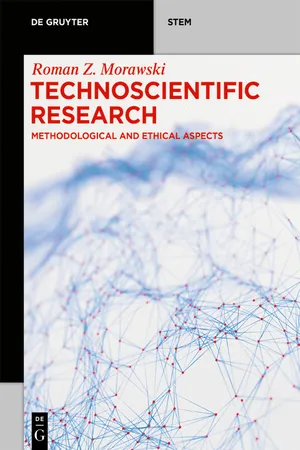Social Sciences
Issues With Technology
Issues with technology encompass a range of social, ethical, and environmental concerns arising from the development and use of technological innovations. These may include privacy breaches, digital divide, job displacement, and environmental impact. Addressing these issues requires a multidisciplinary approach that considers the intersection of technology with society, politics, and the environment.
Written by Perlego with AI-assistance
Related key terms
1 of 5
3 Key excerpts on "Issues With Technology"
- eBook - PDF
- Tanya F. Johnson(Author)
- 1999(Publication Date)
- Greenwood(Publisher)
14 Ethical Issues in a High-Tech Society Gari Lesnoff-Caravaglia Contemporary deliberations regarding the effects of technology upon society have their roots in debates that originated as far back as seven centuries ago. It is important to recognize that long before the dramatic changes precipitated by the Industrial Revolution could be firmly implanted on a large scale, such changes had to be foreshadowed by a slowly evolving reorientation of human wishes, habits, ideas, and goals. Viewing the growth of technology as springing from a network of relation- ships tied to a host of other cultural factors leads to a better understanding of the present applications of technology, the areas of technological growth and expansion currently being fostered, and present attitudes with respect to present and future possible uses of technology, as well as the ways in which technology has altered not only the exterior but also the interior worlds of human experi- encing. Such a broad view also allows for an evaluation of the level of accep- tance or rejection of technology, along with the range of fears that technological expansion has engendered. Within the contemporary context, the unprecedented rapid growth of tech- nology has given a new cast to such development. Furthermore, technology is being increasingly coupled with yet another unprecedented historical event, that of a burgeoning older population. The presence of large numbers of persons aged 65 or older in the nation is leading to changes as novel and dramatic as those experienced during the First Industrial Revolution. Such population changes, experienced for the first time with no historical models to draw upon, are necessitating wide-scale alterations within society that only a uniting of this demographic phenomenon with technology can hope to meet. - eBook - PDF
Technoscientific Research
Methodological and Ethical Aspects
- Roman Z. Morawski(Author)
- 2019(Publication Date)
- De Gruyter(Publisher)
19 Ethical issues implied by information technologies Information technology (IT) will be understood in this chapter as “the technology involving the development, maintenance and use of computer systems, software and networks for the processing and distribution of data” 1 . Hardware and software prod- ucts of IT are inseparable elements of the technoscientific research infrastructure. Computers and computer networks are used to process technoscientific and formal data (information), to control experiments and process their results, as well as to edit reports and publications, while telecommunication means enable the exchange of those data and organisation of research processes, conferences and remote experi- ments. These are important reasons behind inclusion of selected elements of IT ethics in this book devoted to methodological and ethical aspects of technoscientific re- search. After introductory considerations in Section 19.1, the following issues will be covered in the consecutive sections: an outline of ethical issues related to the use of IT means by modern society (Section 19.2), general characterisation of basic problems related to their use in technoscience (Section 19.3) and a more detailed overview of ethical issues related to the use of the internet (Section 19.4). 19.1 Information technology in the age of globalisation Information technology is a product of technoscientific progress, which in turn de- cisively contributes to the acceleration of this progress. Since wide access to IT means is an important competitive advantage of rich countries having high GDP per capita, it can deepen the socio-economic divide between the richest and poorest countries of the world 2 . On the other hand, however, IT development is an opportu- nity for the latter to solve many previously unsolvable problems since it entails cre- ation of a huge number of relatively low-cost jobs. - eBook - PDF
- G.Michael Schneider, Judith Gersting(Authors)
- 2018(Publication Date)
- Cengage Learning EMEA(Publisher)
For example, you have read about the mathematics of algorithmic efficiency (Chapter 3), the hardware implementation of computer systems (Chapters 4 and 5), computer networks (Chapter 7), and software development (Chapters 9 and 10). However, in this chapter, we focus on the human issues lurking behind these technical details. We can’t provide a comprehensive list of such issues; such a list would be way too long, and it is growing daily. Instead, we introduce skills that will help you to think and reason carefully when mak-ing personal decisions about computing. This chapter also discusses impor-tant societal issues related to information technology and personal privacy and points you toward resources to help you explore these issues in greater detail. Making critical decisions about computing technology is unavoid-able. Increasingly, our society is being driven by the access to and control of Copyright 2019 Cengage Learning. All Rights Reserved. May not be copied, scanned, or duplicated, in whole or in part. Due to electronic rights, some third party content may be suppressed from the eBook and/or eChapter(s). Editorial review has deemed that any suppressed content does not materially affect the overall learning experience. Cengage Learning reserves the right to remove additional content at any time if subsequent rights restrictions require it. 793 information. As citizens of our communities, our country, and the world, we want our decisions to be well informed and well reasoned. Whenever humans make decisions about things they value, there are con-flicts and trade-offs. The field of ethics , the study of moral philosophy, has a long history of looking at how to identify and resolve such conflicts, and we will borrow from several classical theories of ethics. In this chapter, we pres-ent a number of case studies built around complex ethical issues related to computing and information.
Index pages curate the most relevant extracts from our library of academic textbooks. They’ve been created using an in-house natural language model (NLM), each adding context and meaning to key research topics.


